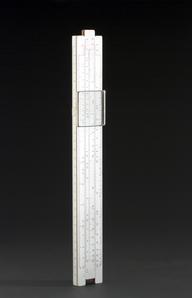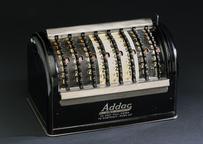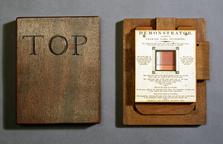

Calculating rule by Lenoir in centimetres with conversions
- maker:
- Etienne Lenoir




10 inch calculating rule by Lenoir in centimetres with conversions. Early 19th century
The French were the first to adopt the metric system in 1795, a decimal-based standard system of weights and measurements. Despite its official endorsement by the government, the metric system’s adoption was met with resistance. This 25 cm slide rule made in the early 19th century, a period of scientific and political change in France, just after the Revolution, shows the metric system in centimeters and millimeters as well as traditional units (measure usuelles in French). The interior has depth and measure conversion scales. At the back, the look-up tables for densities of various materials e.g. copper, lead, mercury include litres and their equivalent in the traditional unit ‘pinte’.
Slide rules that calculate by adding and subtracting logarithmic distances were produced primarily in England since the 17th century for specific uses and trades such as gauging (calculating the contents of alcoholic spirits to determine tax), carpentry, navigation and surveying. It was industrialisation’s need for higher precision and accuracy that led to the slide rule’s improvement and made it the main tool for complex calculations throughout the 19th and 20th centuries. This rule follows the "Soho" arrangement of logarithmic scales, named after the Watts and Boulton foundry in Birmingham. James Watt with John Southern designed this style of slide rule, known as engineer’s slide rule, to aid more precise and accurate calculations essential for the design of steam engines.
In France, slide rules were just introduced in the 19th century but similarly to England their popularisation went hand in hand with increased industrialisation. Étienne Lenoir was one of the most prominent scientific instrument makers of Revolutionary France. With his son, Paul-Étienne, he run a specialized workshop in Paris famous for the construction of precision instruments. It’s then no surprise that he was tasked with designing and producing the first slide rules in France. After staying in England, his commissioner, geographic engineer Edme-François Jomard brought back samples of slide rules. As a member of the ‘Society for the Encouragement of the National Industry’, whose main goal was to put science at the service of industrial advancement, advocated for the mass production and use of the slide rule in France as a simple and accessible instrument of general use. It took about a decade for the prototype to be created and then rules were mass produced in affordable wooden models while Lenoir also produced more luxurious versions in copper and ivory. The publication of manuals and magazine articles along with free workshops on the rule’s use made the Lenoir slide rule popular especially in civil and military engineering. Étienne outlived his son and died in 1832 from when onwards his company under the name Gravet-Lenoir and later Tavernier-Grave became known as one of the best slide rule producers in Europe.
Details
- Category:
- Mathematics
- Object Number:
- 1994-1082
- Materials:
- wood (unidentified)
- type:
- slide rule
- credit:
- Tesseract



